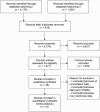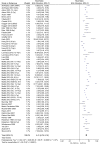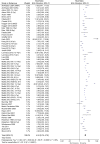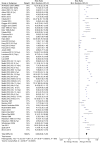Interrelationships between Atopic Disorders in Children: A Meta-Analysis Based on ISAAC Questionnaires
- PMID: 26135565
- PMCID: PMC4489894
- DOI: 10.1371/journal.pone.0131869
Interrelationships between Atopic Disorders in Children: A Meta-Analysis Based on ISAAC Questionnaires
Abstract
Purpose: To study the prevalence and interrelationship between asthma, allergic rhinitis and eczema using data obtained from ISAAC questionnaires.
Method: The Medline, Pubmed Publisher, EMBASE, Google Scholar and the Cochrane Controlled Clinical Trials Register databases were systematically reviewed to evaluate epidemiological data of children with atopic disorders. To study these interrelationships, a new approach was used. Risk ratios were calculated, describing the risk of having two different atopic disorders when the child is known with one disorder.
Results: Included were 31 studies, covering a large number of surveyed children (n=1,430,329) in 102 countries. The calculated worldwide prevalence for asthma, eczema and allergic rhinitis is 12.00% (95% CI: 11.99-12.00), 7.88% (95% CI: 7.88-7.89) and 12.66% (95% CI: 12.65-12.67), respectively. The observed prevalence [1.17% (95% CI: 1.17-1.17)] of having all three diseases is 9.8 times higher than could be expected by chance. For children with asthma the calculated risk ratio of having the other two disorders is 5.41 (95% CI: 4.76-6.16), for children with eczema 4.24 (95% CI: 3.75-4.79), and for children with allergic rhinitis 6.20 (95% CI: 5.30-7.27). No studied confounders had a significant influence on these risk ratios.
Conclusions: Only a minority of children suffers from all three atopic disorders, however this co-occurrence is significantly higher than could be expected by chance and supports a close relationship of these disorders in children. The data of this meta-analysis supports the hypothesis that there could be a fourth distinct group of children with all three disorders. Researchers and clinicians might need to consider these children as a separate group with distinct characteristics regarding severity, causes, treatment or prognosis.
Conflict of interest statement
Figures
References
-
- Strachan D, Sibbald B, Weiland S, Ait-Khaled N, Anabwani G, Anderson HR, et al. Worldwide variations in prevalence of symptoms of allergic rhinoconjunctivitis in children: the International Study of Asthma and Allergies in Childhood (ISAAC). Pediatr Allergy Immunol. 1997;8(4):161–76. . - PubMed
-
- The International Study of Asthma and Allergies in Childhood (ISAAC) Steering Committee. Worldwide variation in prevalence of symptoms of asthma, allergic rhinoconjunctivitis, and atopic eczema: ISAAC. Lancet. 1998;351(9111):1225–32. . - PubMed
-
- The International Study of Asthma and Allergies in Childhood (ISAAC) Steering Committee. Worldwide variations in the prevalence of asthma symptoms: the International Study of Asthma and Allergies in Childhood (ISAAC). Eur Respir J. 1998;12(2):315–35. . - PubMed
-
- Williams H, Robertson C, Stewart A, Ait-Khaled N, Anabwani G, Anderson R, et al. Worldwide variations in the prevalence of symptoms of atopic eczema in the International Study of Asthma and Allergies in Childhood. J Allergy Clin Immunol. 1999;103(1 Pt 1):125–38. . - PubMed
Publication types
MeSH terms
LinkOut - more resources
Full Text Sources
Other Literature Sources
Medical






